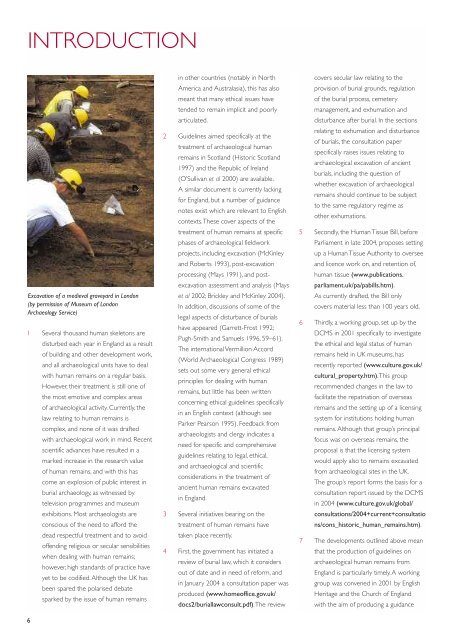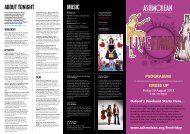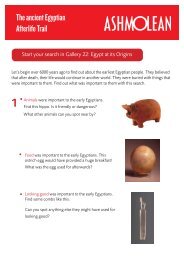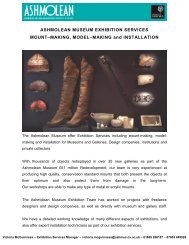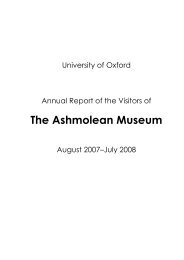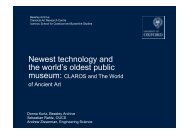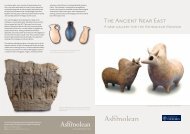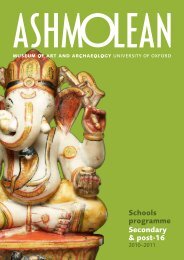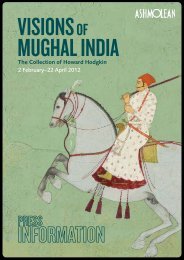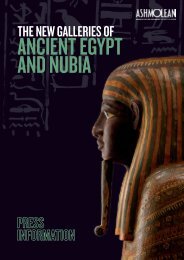English Heritage and the Church of England Guidance for best ...
English Heritage and the Church of England Guidance for best ...
English Heritage and the Church of England Guidance for best ...
Create successful ePaper yourself
Turn your PDF publications into a flip-book with our unique Google optimized e-Paper software.
INTRODUCTION<br />
in o<strong>the</strong>r countries (notably in North<br />
America <strong>and</strong> Australasia), this has also<br />
meant that many ethical issues have<br />
tended to remain implicit <strong>and</strong> poorly<br />
articulated.<br />
2 Guidelines aimed specifically at <strong>the</strong><br />
treatment <strong>of</strong> archaeological human<br />
remains in Scotl<strong>and</strong> (Historic Scotl<strong>and</strong><br />
1997) <strong>and</strong> <strong>the</strong> Republic <strong>of</strong> Irel<strong>and</strong><br />
(O’Sullivan et al 2000) are available.<br />
A similar document is currently lacking<br />
<strong>for</strong> Engl<strong>and</strong>, but a number <strong>of</strong> guidance<br />
notes exist which are relevant to <strong>English</strong><br />
contexts.These cover aspects <strong>of</strong> <strong>the</strong><br />
treatment <strong>of</strong> human remains at specific 5<br />
phases <strong>of</strong> archaeological fieldwork<br />
projects, including excavation (McKinley<br />
<strong>and</strong> Roberts 1993), post-excavation<br />
processing (Mays 1991), <strong>and</strong> postexcavation<br />
assessment <strong>and</strong> analysis (Mays<br />
Excavation <strong>of</strong> a medieval graveyard in London et al 2002; Brickley <strong>and</strong> McKinley 2004).<br />
(by permission <strong>of</strong> Museum <strong>of</strong> London<br />
In addition, discussions <strong>of</strong> some <strong>of</strong> <strong>the</strong><br />
Archaeology Service)<br />
legal aspects <strong>of</strong> disturbance <strong>of</strong> burials<br />
6<br />
have appeared (Garrett-Frost 1992;<br />
1 Several thous<strong>and</strong> human skeletons are<br />
Pugh-Smith <strong>and</strong> Samuels 1996, 59–61).<br />
disturbed each year in Engl<strong>and</strong> as a result<br />
The international Vermillion Accord<br />
<strong>of</strong> building <strong>and</strong> o<strong>the</strong>r development work,<br />
(World Archaeological Congress 1989)<br />
<strong>and</strong> all archaeological units have to deal<br />
sets out some very general ethical<br />
with human remains on a regular basis.<br />
principles <strong>for</strong> dealing with human<br />
However, <strong>the</strong>ir treatment is still one <strong>of</strong><br />
remains, but little has been written<br />
<strong>the</strong> most emotive <strong>and</strong> complex areas<br />
concerning ethical guidelines specifically<br />
<strong>of</strong> archaeological activity. Currently, <strong>the</strong><br />
in an <strong>English</strong> context (although see<br />
law relating to human remains is<br />
Parker Pearson 1995). Feedback from<br />
complex, <strong>and</strong> none <strong>of</strong> it was drafted<br />
archaeologists <strong>and</strong> clergy indicates a<br />
with archaeological work in mind. Recent<br />
need <strong>for</strong> specific <strong>and</strong> comprehensive<br />
scientific advances have resulted in a<br />
guidelines relating to legal, ethical,<br />
marked increase in <strong>the</strong> research value<br />
<strong>and</strong> archaeological <strong>and</strong> scientific<br />
<strong>of</strong> human remains, <strong>and</strong> with this has<br />
considerations in <strong>the</strong> treatment <strong>of</strong><br />
come an explosion <strong>of</strong> public interest in<br />
ancient human remains excavated<br />
burial archaeology, as witnessed by<br />
in Engl<strong>and</strong>.<br />
television programmes <strong>and</strong> museum<br />
exhibitions. Most archaeologists are 3 Several initiatives bearing on <strong>the</strong><br />
conscious <strong>of</strong> <strong>the</strong> need to af<strong>for</strong>d <strong>the</strong><br />
treatment <strong>of</strong> human remains have<br />
dead respectful treatment <strong>and</strong> to avoid taken place recently.<br />
7<br />
<strong>of</strong>fending religious or secular sensibilities<br />
4 First, <strong>the</strong> government has initiated a<br />
when dealing with human remains;<br />
review <strong>of</strong> burial law, which it considers<br />
however, high st<strong>and</strong>ards <strong>of</strong> practice have<br />
out <strong>of</strong> date <strong>and</strong> in need <strong>of</strong> re<strong>for</strong>m, <strong>and</strong><br />
yet to be codified. Although <strong>the</strong> UK has<br />
in January 2004 a consultation paper was<br />
been spared <strong>the</strong> polarised debate<br />
produced (www.home<strong>of</strong>fice.gov.uk/<br />
sparked by <strong>the</strong> issue <strong>of</strong> human remains<br />
docs2/buriallawconsult.pdf).The review<br />
covers secular law relating to <strong>the</strong><br />
provision <strong>of</strong> burial grounds, regulation<br />
<strong>of</strong> <strong>the</strong> burial process, cemetery<br />
management, <strong>and</strong> exhumation <strong>and</strong><br />
disturbance after burial. In <strong>the</strong> sections<br />
relating to exhumation <strong>and</strong> disturbance<br />
<strong>of</strong> burials, <strong>the</strong> consultation paper<br />
specifically raises issues relating to<br />
archaeological excavation <strong>of</strong> ancient<br />
burials, including <strong>the</strong> question <strong>of</strong><br />
whe<strong>the</strong>r excavation <strong>of</strong> archaeological<br />
remains should continue to be subject<br />
to <strong>the</strong> same regulatory regime as<br />
o<strong>the</strong>r exhumations.<br />
Secondly, <strong>the</strong> Human Tissue Bill, be<strong>for</strong>e<br />
Parliament in late 2004, proposes setting<br />
up a Human Tissue Authority to oversee<br />
<strong>and</strong> licence work on, <strong>and</strong> retention <strong>of</strong>,<br />
human tissue (www.publications.<br />
parliament.uk/pa/pabills.htm).<br />
As currently drafted, <strong>the</strong> Bill only<br />
covers material less than 100 years old.<br />
Thirdly, a working group, set up by <strong>the</strong><br />
DCMS in 2001 specifically to investigate<br />
<strong>the</strong> ethical <strong>and</strong> legal status <strong>of</strong> human<br />
remains held in UK museums, has<br />
recently reported (www.culture.gov.uk/<br />
cultural_property.htm).This group<br />
recommended changes in <strong>the</strong> law to<br />
facilitate <strong>the</strong> repatriation <strong>of</strong> overseas<br />
remains <strong>and</strong> <strong>the</strong> setting up <strong>of</strong> a licensing<br />
system <strong>for</strong> institutions holding human<br />
remains. Although that group’s principal<br />
focus was on overseas remains, <strong>the</strong><br />
proposal is that <strong>the</strong> licensing system<br />
would apply also to remains excavated<br />
from archaeological sites in <strong>the</strong> UK.<br />
The group’s report <strong>for</strong>ms <strong>the</strong> basis <strong>for</strong> a<br />
consultation report issued by <strong>the</strong> DCMS<br />
in 2004 (www.culture.gov.uk/global/<br />
consultations/2004+current+consultatio<br />
ns/cons_historic_human_remains.htm).<br />
The developments outlined above mean<br />
that <strong>the</strong> production <strong>of</strong> guidelines on<br />
archaeological human remains from<br />
Engl<strong>and</strong> is particularly timely. A working<br />
group was convened in 2001 by <strong>English</strong><br />
<strong>Heritage</strong> <strong>and</strong> <strong>the</strong> <strong>Church</strong> <strong>of</strong> Engl<strong>and</strong><br />
with <strong>the</strong> aim <strong>of</strong> producing a guidance<br />
6


